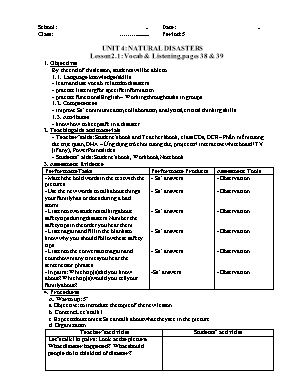Giáo án môn Tiếng Anh 8 - Unit 4: Natural disasters - Lesson 2.1: Vocab & listening
1. Objectives
By the end of this lesson, students will be able to
1.1. Language knowledge/ skills
- learn and use vocab. related to disasters
- practice listening for specific information
- practice functional English – Working through tasks in groups
1.2. Competences
- improve Ss’ communication, collaboration, analytical, critical thinking skills.
1.3. Attributes
- know how to keep safe in a disaster.
2. Teaching aids and materials
- Teacher’s aids: Student’s book and Teacher’s book, class CDs, DCR– Phần mềm tương tác trực quan, DHA – Ứng dụng trò chơi tương tác, projector / interactive whiteboard /TV (if any), PowerPoint slides.
- Students’ aids: Student’s book, Workbook, Notebook.
Bạn đang xem tài liệu "Giáo án môn Tiếng Anh 8 - Unit 4: Natural disasters - Lesson 2.1: Vocab & listening", để tải tài liệu gốc về máy hãy click vào nút Download ở trên
Tóm tắt nội dung tài liệu: Giáo án môn Tiếng Anh 8 - Unit 4: Natural disasters - Lesson 2.1: Vocab & listening

School: .. Date:.. Class: ..................... Period: 5 UNIT 4: NATURAL DISASTERS Lesson 2.1: Vocab & Listening, pages 38 & 39 1. Objectives By the end of this lesson, students will be able to 1.1. Language knowledge/ skills - learn and use vocab. related to disasters - practice listening for specific information - practice functional English – Working through tasks in groups 1.2. Competences - improve Ss’ communication, collaboration, analytical, critical thinking skills. 1.3. ... to talk about things your family has or does during a bad storm. - Listen to two students talking about safety tips during disasters. Number the safety tips in the order you hear them - Listen again and fill in the blanks to know why you should follow these safety tips. - Listen to the conversation again and count how many times you hear the sentences or phrases. - In pairs: Which tip(s) did you know about? Which tip(s) would you tell your family about? - Ss’ answers. - Ss’ answers. ...his kind of disaster? - Ask Ss to work in pairs to talk about what happened in the picture and what people should do in this kind of disaster. - Pick some Ss to share their ideas. - Give feedback. - Talk with their partner about what happened in the picture and what people should do in this kind of disaster. - Share their ideas. B. New lesson (35’) 1. Vocabulary: 15’ a. Objective: to help Ss know more vocabulary related to disasters. b. Content: tasks a & b. c. Expected outcome: Ss ...ick some Ss to say the words and correct their pronunciation if necessary. - Check their memory by playing a game in pairs: Student A say the definition; Student B say the word (with books closed). Task b. In pairs: Use the new words to talk about things your family has or does during a bad storm. -Ask Ss to work in pairs to use the new words to talk about things your family has or does during a bad storm. - Pick some Ss to share their ideas. - Give feedback. - Read the sentences, underli...- Share their ideas. Sample answer: We stock up on batteries. 2. Listening: 20 minutes a. Objective: to help Ss practice listening for specific information and know how to talk when working through tasks in groups. b. Content: tasks a, b, c, d, and e. c. Expected outcomes: Ss can listen and get the safety tips during a disaster; use functional English while working in groups. d. Organization: Teacher’s activities Students’ activities Task a: Listen to two students talking about safety t...ety tips. 1. because something could __________ on your head. 2. because the __________ may move to people's houses. 3. because it's __________ to be on high ground. 4. because it could carry you __________. 5. because strong __________ can break windows and doors. - Ask Ss to guess the type of words in the gaps. - Pick some Ss to share their ideas. - Give feedback. - Ask Ss to listen and fill in the gaps. - Let Ss check with their partner. - Pick some students to give their answers...rough tasks in groups. - Check their answers. - Get Ss to listen and repeat. Task d: Now, listen to the conversation again and count how many times you hear the sentences or phrases. -Ask Ss to listen to the conversation again and count how many times you hear the sentences or phrases. -Pick some students to give their answers. -Check their answer. -Read the Conversation Skill box and say the phrases that can be used when working through tasks in groups. Answer keys: What's next? Ne...e Ss to share their ideas. - Give feedback. - Work in pairs, answering the question: Which tip(s) did you know about? Which tip(s) would you tell your family about? - Share their ideas. C. Consolidation and homework assignments: 5’ - Vocabulary: escape plan, board up, emergency services, fire extinguisher, stock up, batteries, first aid kit, supplies. - Do exercises in workbook on page 22. - Prepare the next lesson: Lesson 2.2 - Grammar, pages 39 & 40 - Do the exercises in Tiếng Anh 8 i-
File đính kèm:
 giao_an_mon_tieng_anh_8_unit_4_natural_disasters_lesson_2_1.docx
giao_an_mon_tieng_anh_8_unit_4_natural_disasters_lesson_2_1.docx

